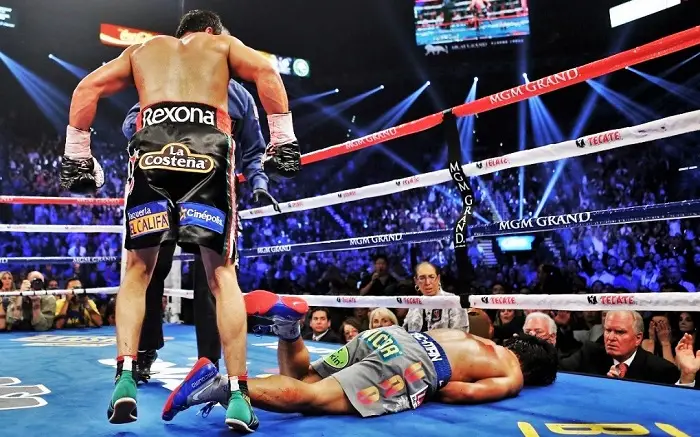Cameron Allen
Table of Contents
In the intricate world of boxing, fighters often face losses or feel as if they need a break fighting against challenging opponents. This is where Tune-up fights come into play, they act as a de-load fight to help boxers get back on their feet.
Read below to learn all about Tune up fights, how they work, and some memorable examples.

What is a tune-up fight and when are they used?
A tune-up fight is a term commonly used in combat sports, like professional boxing or MMA. It refers to a fight that a fighter takes on to prepare for big fights. Tune-up fights, also known as warm-up fights are usually against opponents who are less skilled or experienced.
Ultimately allowing the fighter to work on their techniques, conditioning, and strategy before stepping into the ring with a tougher opponent, usually against a top contender. These fights are usually an easy win and they’re used to fine-tune their skills and build confidence.
The Purpose Behind Tune-Up Fights
The main purpose behind a tune-up fight is to help fighters sharpen their skills and regain their form after a period of inactivity or a loss, a stay-busy fight if you may.
Tune-ups are strategically planned to provide the fighter with an opportunity to work on specific aspects of their game, such as footwork, defense, or offense, without facing a highly competitive opponent right away.
A Tune-up fight allows a fighter to assess their current abilities, identify weaknesses, and make necessary adjustments before stepping into a big fight. Tune-ups are like a warm-up in the boxing ring before the main event, helping fighters regain their confidence, and momentum and fix any ring rust.

When Tune-Up Fights Go Wrong
At times, tune-up fights can go wrong, which is quite disappointing and frustrating for the fighter and their fans. Most of the time, these are stay-busy fights that are meant to be relatively easy wins for the fighter, but things do not always go as planned.
There have been memorable instances where the opponent, who was supposed to be an easy challenge, turned out more competitive than expected. This can result in a long, tough, and unexpected fight for the fighter looking for an easy win. A fight like this can potentially lead to a loss or barely winning through a unanimous decision.
A hard tune-up fight in the boxing ring can be a setback in terms of confidence and preparation for future matches. However, fighters need to learn from these experiences, put in the work, and make the necessary adjustments to bounce back stronger. It goes to show that athletes must be ready for anything and everything in a professional boxing ring.
One example of USA boxing is when Mike Tyson fought against Buster Douglas in 1990. Douglas was considered an underdog, but he shocked the world by knocking out the champion and ending his undefeated streak.
Another prime example is when Anthony Joshua, a heavyweight champion, fought Andy Ruiz Jr. in 2019. Ruiz was a late replacement opponent and was not expected to pose a significant challenge. However, Ruiz shocked boxers all around the world by defeating Joshua, claiming the heavyweight champion title.
Understanding Boxers’ Training Cycles
The first phase of the training cycle is the off-season, where fighters focus on recovery and rest. Then comes the pre-season, where they gradually increase their training intensity and work on building their explosive strength and cardiovascular endurance. After this comes the in-season, which is mainly specific boxing training, such as sparring and refining techniques.
As the fight is right around the corner, boxers enter the peaking phase, where they fine-tune their skills, increase their intensity, and focus on weight-cutting. After the fight comes the post-season, where fighters take time to recover and reflect on their performance.
Risks and Benefits of Tune-Up Fights
Tune-up fights come with a variety of risks and benefits. One of the main advantages is that they provide boxers with an opportunity to fine-tune their skills, build confidence, and regain their form in the ring after a period of inactivity or a loss.
These fights allow them to work on specific aspects of their game without the intense pressure of a high-stakes fight. It’s like an opportunity to practice and experiment with different strategies. Overall, tune-up fights can help generate buzz and excitement for the athlete, keeping their name in the spotlight and maintaining their strong fan base.

However, there are also some risks involved. One major risk is when fighters underestimate their opponent. At times, fighters may not take their tune-up fights as seriously as they would a bigger fight, assuming an easy victory. An easygoing mindset like this can lead to complacency and a lack of preparation, resulting in unexpected losses or tougher fights than anticipated.
Another major risk is the potential for injury. Even though tune-up fights are meant to be less challenging, there’s still a chance of getting hurt. Lastly, there’s the risk of damaging the fighter’s reputation and self-esteem. If they perform poorly or lose in a tune-up fight against a lower-ranked fighter, it can negatively impact their image and future opportunities.
Overall, tune-up fights can be beneficial for fighters to fine-tune their skills, regain confidence, and build momentum, but they must approach them with the right mindset and preparation to avoid potential risks and setbacks like injuries and losses.
Benefits of having a Tune-Up Fight:
- Opportunity to fine-tune skills against an easier opponent
- Regaining confidence in the ring after a previous loss
- Gaining popularity and staying in the highlights of boxing news
- Easy wins to improve a winning streak
Risks of having a Tune-Up Fight:
- Risk of getting severely hurt
- Unexpectedly hard fights against underdog opponents
- Damaged reputation after losing to a lower-ranked fighter
- Self-esteem might get hurt losing a stay-busy fight
The Venum Impact is one of their best sellers because of the triple-density foam used to enhance protection and shock absorption in your hands and wrists.
Examples of Memorable Tune-Up Fights
There are many examples of modern and old yet legendary examples of Tune-up fights.
A prime example is when Canelo Alvarez met Rocky Fielding in 2018. The Mexican superstar moved up a weight class to challenge Fielding for the super middleweight title. It was expected to be a one-sided fight, but Fielding put up a brave and competitive fight before Canelo ultimately knocked him out in the third round, capturing yet another world title.
In 2020, Gervonta Davis faced Leo Santa Cruz in a memorable tune-up fight. “Tank”, who was a rising star in the sport, was expected to showcase his skills against a dangerous boxer, Santa Cruz. The fight delivered an exciting back-and-forth war, with Davis ultimately landing a powerful uppercut in the sixth round, knocking Santa Cruz out cold and claiming the super featherweight title.
Another iconic match-up was when Muhammad Ali faced Jimmy Young in 1976. Ali was coming off a loss to Joe Frazier and was looking to regain his form and fix any ring rust. However, Young, who was considered a tune-up opponent, put up a tremendous fight, showcasing his sharp defensive skills. The fight ended in a controversial draw, leaving everyone surprised and worried for Ali’s future.
Another well-known tune-up fight was when Manny Pacquiao fought Jeff Horn in 2017. Pacquiao, who was a legendary fighter and multi-division champion, was expected to dominate Horn, who was relatively unknown at the time. However, Horn proved to be an underdog put up a valiant effort, and won a controversial decision, shocking the boxing world.
Criticisms and Controversies Surrounding Tune-Up Fights
Tune-up fights in boxing have had their fair share of criticisms and controversies. One major criticism is that these fights are often boring and can sometimes lack competitiveness and excitement. The reason for this is that they are often arranged to provide an easy victory for the favored fighter.
Some fans argue that these matchups are a way for established fighters to pad their records and avoid taking on more challenging opponents. This can be disappointing for fans who are hoping for thrilling and competitive bouts.
Additionally, controversies arise when the underdog unexpectedly performs well or even defeats the favored fighter in the tune-up fight, causing questions about the future of the favored fighter and raising concerns about potential mismatches.
Overall, while tune-up fights serve an important purpose in preparing fighters for bigger contenders and fights, they are not immune to criticisms and controversies within the combat sports community.

Evolution of Tune-Up Fights in Modern Boxing
When it comes to modern boxing, Tune-up fights are still common and effective for boxers in many ways. Rising stars like Gervonta Davis and Ryan Garcia have had multiple tune-up fights leading up to bouts against bigger names.
All in all, tune-up fights have maintained their popularity over the decades, and are still used by fighters to refine their skills and build momentum.
Related Content
The Hayabusa T3 boxing gloves are arguably the Rolls Royce of boxing gloves. These luxurious leather bad boys are packed to the brim with premium features.




